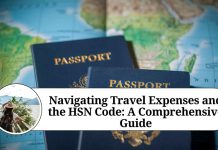Almonds are a popular nut that is consumed around the world for their nutritional value and delicious taste. They are a rich source of healthy fats, protein, fiber, and other essential nutrients that make them a valuable addition to any diet. However, when it comes to importing or exporting almonds, it’s essential to understand the Harmonized System Nomenclature (HSN) code. In this blog, we will explore the almond HSN code and what it means for those involved in the almond trade.
What is the Harmonized System Nomenclature?
The Harmonized System Nomenclature (HSN) is an internationally recognized system for classifying goods. It was developed by the World Customs Organization (WCO) and is used by over 200 countries worldwide. The system uses a standardized six-digit code to classify goods, with additional digits added for more specific categories.
The HSN is used for a range of purposes, including:
- Customs and excise duties
- Trade negotiations
- Statistical analysis of trade flows
- Economic research and analysis
- Monitoring of controlled goods
What is the Almond HSN Code?
The HSN code for almonds is 080212. The first two digits, 08, refer to the chapter “Edible fruits and nuts; peel of citrus fruit or melons.” The next two digits, 02, refer to the heading “Nuts, edible; preparations of nuts, other than groundnuts.” Finally, the last two digits, 12, refer to the subheading “Almonds.”
The HSN code for almonds falls under the broader category of nuts, which also includes walnuts, cashews, and pistachios. However, each type of nut has a different HSN code, allowing for more precise classification and tracking of trade flows.
Why is the Almond HSN Code Important?
The almond HSN code is essential for anyone involved in the trade of almonds, whether importing or exporting. Customs officials use the HSN code to determine the correct tariff or duty rate that should be applied to the almonds. The HSN code also allows for the tracking of trade flows and the monitoring of controlled goods, such as those subject to trade sanctions or embargoes.
Incorrectly classifying goods can result in delays at customs, extra fees, or even legal penalties. Therefore, it is crucial to understand the correct HSN code for almonds to ensure smooth and efficient trade operations.
In Conclusion
The almond HSN code is an essential classification tool for anyone involved in the import or export of almonds. It allows for the precise tracking and classification of almonds and ensures that the correct tariff or duty rate is applied. Understanding the HSN code is essential for smooth and efficient trade operations and can help to avoid potential delays or penalties.
Frequently Asked Questions (FAQs)
Q: What is the almond HSN code?
A: The almond HSN code is 080212.
Q: What does the almond HSN code mean?
A: The HSN code for almonds is a standardized six-digit code used to classify goods. The first two digits, 08, refer to the chapter “Edible fruits and nuts; peel of citrus fruit or melons.” The next two digits, 02, refer to the heading “Nuts, edible; preparations of nuts, other than groundnuts.” Finally, the last two digits, 12, refer to the subheading “Almonds.”
Q: Why is the almond HSN code important?
A: The almond HSN code is essential for anyone involved in the trade of almonds, whether importing or exporting. Customs officials use the HSN code to determine the correct tariff or duty rate that should be applied to the almonds. The HSN code also allows for the tracking of trade flows and the monitoring of controlled goods, such as those subject to trade sanctions or embargoes.
Q: Are there different HSN codes for different types of nuts?
A: Yes, each type of nut has a different HSN code, allowing for more precise classification and tracking of trade flows.
Q: What are some other HSN codes related to almonds?
A: Some related HSN codes include 080231 (shelled walnuts), 080132 (shelled pistachios), and 200819 (nut and fruit mixtures).
Q: How do I find the correct HSN code for my almonds?
A: You can find the correct HSN code for your almonds by consulting the Harmonized System Nomenclature, which is available online through various customs and trade organizations.
Q: What happens if I incorrectly classify my almonds?
A: Incorrectly classifying goods can result in delays at customs, extra fees, or even legal penalties. Therefore, it is crucial to understand the correct HSN code for almonds to ensure smooth and efficient trade operations.




















